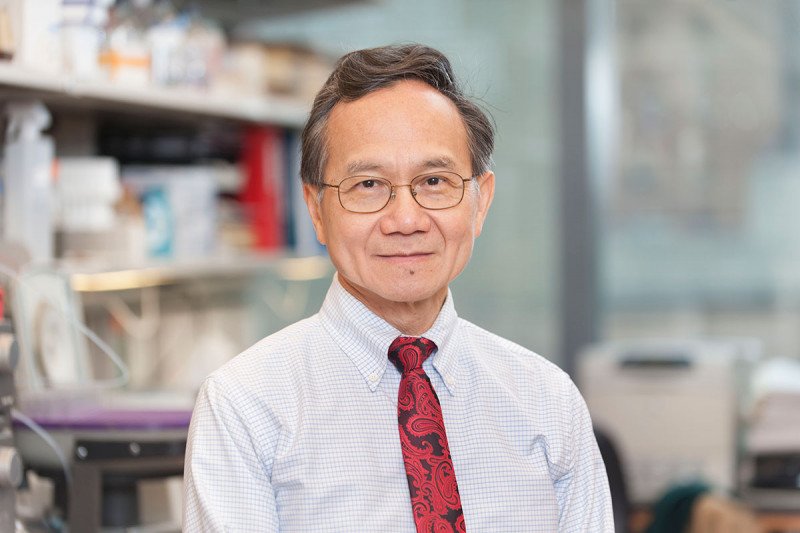
Physician-scientist Nai-Kong Cheung says a new form of treatment looks especially promising for cancers that have spread.
Giving drugs without toxic side effects is a primary goal of cancer treatment. This can be especially challenging for radioimmunotherapy, a form of liquid radiation. Radioimmunotherapy uses an antibody linked to a radioisotope, an unstable chemical element that releases radiation.
When the antibody delivers the radioactive payload to the tumor, it wreaks havoc with the cell’s DNA and causes it to die. But great care must be taken to make sure the radiation doesn’t harm normal cells.
Now, MSK researchers in the laboratories of Memorial Sloan Kettering Cancer Center physician-scientist Nai-Kong Cheung and nuclear medicine physician Steven Larson in the Sloan Kettering Institute have found a way to deliver a strong dose of liquid radiation using an especially potent radioisotope. They reported these findings in September in Clinical Cancer Research. The new therapy has shown promising results in human tumors implanted into mice.
An accompanying commentary by scientists at the National Cancer Institute — who were not involved in the research — highlights this new approach.
This new form of radioimmunotherapy uses a radioisotope called an alpha emitter. The radioisotope releases alpha particles, which are especially destructive to tissue in their path.
Alpha particles have a much bigger mass — thousands of times larger — than the photons used in conventional radiation or beta particles. These alpha particles cause more damage when they slam into cancer cells.
“It’s like the difference between being hit in the head with a fast-moving baseball or a lead basketball,” says Dr. Cheung.
The potency has been a double-edged sword, however, as researchers have been unable to restrict the impact only to cancer cells. “The alpha emitter is the Holy Grail of radioisotope therapy, but until now, no one has been able to give it without toxicity,” Dr. Cheung says.
Critical Parts for Team Science
The new approach combines three advances, all developed at MSK, into a single therapeutic technique. First, a technology is used to keep alpha-emitting radioisotopes locked up safely in a molecular “cage” when inside the body. When they are near cancer cells, the enclosed radioisotopes can still release alpha particles to destroy cancer cells, but the cage prevents the radioisotopes from being absorbed into other tissue before leaving the body.
The molecular cage was developed by Dr. Larson, along with radiochemist Michael McDevitt and senior research scientist Sarah Cheal.
“It’s like we’ve tamed the beast inside the cage,” Dr. Cheung says. “The radioisotope can’t hurt normal tissue, but it can still release the alpha particles through the bars. If the radioisotope does not bind to the tumor, it leaves the body through the urine.”
The second advance, developed by the Cheung Lab, is a technology called a self-assembling and disassembling (SADA) antibody platform. It contains a “bispecific” antibody with two arms. One arm selectively binds to the surface of the tumor cells. The other arm serves as a docking point for the radioisotope cage. The SADA automatically disassembles (breaks down) and is excreted through the urine if it does not bind to the tumor cells.
The third critical part is how the treatment is delivered. First, the SADA, with the antibodies that bind selectively to tumors, are injected. After a day or two — which allows the unbound SADA to disassemble and leave the body — the caged radioisotopes are injected. “The antibodies are there on the tumor cells waiting for the isotopes served in a cage,” Dr. Cheung says.
“Integrating all these inventions finally breaks the treatment barrier that existed for using alpha emitters,” he explains.
Adjustable Therapy
Dr. Cheung says initial studies tested the drug on human neuroblastoma and lung cancer tumors implanted in mice, but his team has begun using the therapy for other human cancers including colorectal cancer. They are using a radioisotope called actinium-225, which was initially developed as a potential cancer treatment by MSK physician-scientist David Scheinberg and Dr. McDevitt in 2011. In 2018, Dr. Larson’s laboratory showed that actinium-225, inside its cage, could be used for the treatment of cancer in mouse models.
A big advantage of the therapy being relayed in two stages is that it is easy to adjust. The antibodies used in the first stage can be swapped as needed to target different cancer types. The caged radioisotope, given separately in the second stage, would not need to change. Giving repeated doses of the radioisotope should also be possible since it clears the body rapidly each time.
“We think this treatment is especially promising for metastatic cancers, which are difficult to control,” Dr. Cheung says. “It could be a good complement to other therapies.”
The SADA and cage technologies have been licensed to the biotechnology company Y-mAbs Therapeutics, which hopes to launch early-stage human trials soon.




